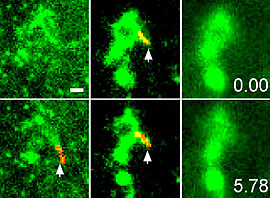| Aug 28, 2008 |
$1.2 million to advance technology that produces 3-D views of cellular processes
|
|
(Nanowerk News) A University of Texas at Dallas researcher has received a $1.2 million award from the National Institutes of Health to further develop a new technology for the three-dimensional microscopic imaging of living cells – technology he believes may produce significant new insights into basic cellular processes.
|
|
"Whereas classical microscopes image one focal plane at a time, cells are three-dimensional objects and cellular processes are not typically restricted to one focal plane," said Dr. Raimund Ober, a professor of electrical engineering at the Erik Jonsson School of Engineering and Computer Science at UT Dallas. "This, combined with the fact that cellular dynamics are often very fast, means that detailed studies are often not possible."
|
 |
| By producing images from three planes at once within a living cell and enabling researchers to track individual molecules' movement across those planes, the new technology promises to provide biologists with a fuller understanding of cellular processes.
|
|
Working with Dr. Sally Ward, a professor of immunology at the University of Texas Southwestern Medical Center, Dr. Ober is determined to change that.
|
|
Last year he and his team announced they'd developed a means to microscopically examine multiple focal planes at once, producing a 3-D view that encompassed both the processes taking place deep within a living cell as well as activities occurring at the cell's outer membrane.
|
|
In this new four-year project they'll now develop algorithms that enable them to precisely follow the movement of individual cellular molecules that are tagged for tracking purposes with nano-particles called quantum dots. Then, to demonstrate the new technology's effectiveness, they'll use it to track a particular protein, the antibody type immunoglobulin G, whose cellular movement has previously resisted researchers' efforts to precisely understand it.
|
|
"This technology promises to overcome significant limitations in existing approaches that have to date prevented researchers from studying central aspects of the functioning of cells," Dr. Ober said. "The new technology will permit investigations that are important to increase our understanding of how cells function."
|
|
Of particular significance, he added, this technology will improve the tools available for studying how cells interact with antibody-based drugs, a young but already very significant and rapidly expanding class of pharmaceuticals that work to target cancer cells, for example, with high specificity.
|
|
"Antibody-based drugs have already provided revolutionary treatments for a number of devastating diseases such as cancer and rheumatoid arthritis," he said, "and it's very exciting to be involved in research that has such promise of providing relief to people suffering from terrible diseases."
|
|
|

